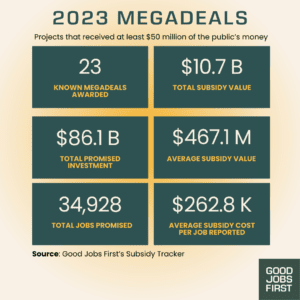Whereas we dubbed 2022 a “mega-year” for megadeals, the decreasing costs and number of deals in 2023 suggest a cooling-off period for state and local subsidy decision-makers this year.

Sixteen states approved “megadeals,” which means at least $50 million in public subsidies went toward privatized industries. The state of Michigan led the nation with big announcements, committing to just shy of $2.8 billion among three economic development deals this year. Michigan also got the record for the largest megadeal recipient for any project this year – Ford’s electric vehicle (EV) plant in Marshall.
In all, we added 23 new megadeals to Subsidy Tracker, our database that captures hundreds of state and local economic development subsidies. Three companies extracted deals worth over $1 billion.
Among the deals we analyzed, we note:
- EV and EV battery production was the most heavily subsidized industry in 2023. Eight states announced $5.8 billion of public subsidies in electric vehicle or battery manufacturing facilities this year. Significant investments like Ford’s EV factory in Marshall, Michigan, came the same year the UAW organized a stand-up strike against Ford and other large automakers, securing better wages and benefits.
- State disclosure of job obligations was, for the most part, surprisingly comprehensive. The public is often left in the dark about the details of multi-incentive deals, such as new jobs, wage targets, and the amount of private investment. However, only two out of 20 deals did not include a required number of jobs, and six did not include wages, including Amazon’s $1 billion deal in Oregon for data centers. Of the 18 projects with job creation targets, the average per-job subsidy cost was over $262,000.

Note: These values only reflect the summary of deals recorded by Good Job First’s Subsidy Tracker and not all potential deals.
Looking ahead: Our predictions for 2024
Our research indicates three project types will most likely be heavily subsidized next year: EVs, semiconductors, and data centers.
Over the past two years, we’ve seen a boom in EVs and battery manufacturing investments. While we see megadeals in this industry slowing down, we also see drops in announced investments in size and number. Ford has already announced plans to scale back the jobs and investment for their EV plant in Marshall, Michigan.
We anticipate seeing new subsidies to entice semiconductor manufacturing. Many will benefit from federal subsidies – we expect to see communities step in to demand good wages and benefits to ensure permanent jobs. Construction workers can expect living wages thanks to requirements included in the CHIPS and Science Act; lamentably, permanent workers have no such protections.
Finally, emergent artificial intelligence and other advanced software technologies could become growing challenges due to their strain on local resources. Data centers, for example, require a lot of electricity and land to house their cloud computing infrastructure – and AI and cryptocurrency mining are only exacerbating that demand. Data center operators have also begun pushing state and local governments for significant tax breaks in addition to their demand for physical resources.
Subsidy data transparency today and tomorrow
In assessing how many megadeals happened in 2023, one factor that may be at play is poor governmental transparency about incentive awards in many places. Over the next couple of years, as details of those deals trickle out, we expect to learn more about additional megadeals, who the recipients are, how much they got, and the impact on other jobs in local labor markets.
I hope you’ll indulge us in letting us make a New Year’s resolution for private firms and public agencies. In that case, we hope they make transparency and equity a central part of their economic development resolutions. Until then, Good Jobs First will continue to monitor public investments in private industries to ensure that rather than simply taking the public’s money, the projects benefit and empower working communities and families.